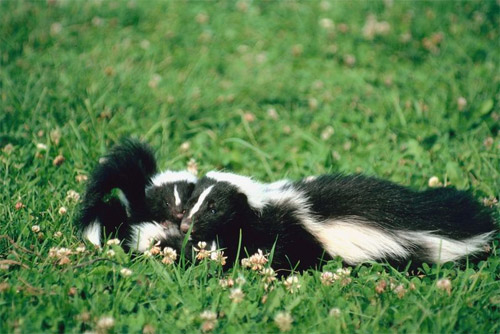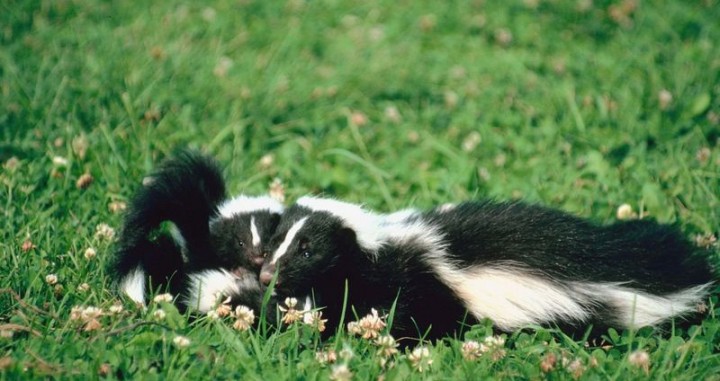How in the World Do You Get a Stuck Skunk out of a Bottle? | Yankee Classic
What would you do if you came across a stuck skunk trapped in a glass bottle? Bob Connors did, and he’s here to tell the tale.

Excerpt from “How in the World Do You Get a Stuck Skunk out of a Bottle,” Yankee Magazine, June 1991.

The sandy dirt of Canterbury Road is just right as I pant my way past Johnson’s hayfield. The air cool enough for delight but not cold enough for long johns and stocking cap, the early sun slanting low. No sound but my labored breathing and the chunking noise of sneakers on dirt. Just another morning. Or so I think.
Then I see him, off to my right. Twenty-five feet or so from the road in a cut-over hayfield. A skunk. One of the kind that are mostly white, with the black mainly on their sides. From the corner of my eye I watch him turn, move. I detour to the other side of the road.
But something seems wrong, in the way that he moves or the way that he looks. Some glint of strangeness. I slow my pace, looking over my right shoulder. The skunk moves through the stubble toward the road. I stop and shade my eyes against the low sunlight. The skunk comes closer. And then I see it.
A glass jar. About 4-1/2 inches long, about three inches in diameter, with a pinched-in neck — a large baby-food jar, perhaps. It is jammed over the skunk’s head, completely covering it past the ears. Unable to hear or smell, the skunk raises his head in a clumsy, unnatural way. His dim eyes catch sight of my bright purple warm-up jacket. He begins, slowly but unmistakably, to come toward me.
As you probably know, this is not what skunks or any wild animals typically do. But as I stand on the bright, hard-packed road, this stuck skunk is clearly coming toward me. More, I can’t help but feel that he is coming to me.
I begin to talk to him. Only later does it occur to me that he is probably unable to hear anything with the jar on his head, but the talk is more for my sake anyway.
“Oh, boy, “l say, as the skunk trundles closer, “if you aren’t a textbook case in conservation ethics, I’ve never seen one.” I back away a step. What if he’s rabid? He lifts his head, feebly, to the right, to the left. I can see the long white silky hairs of his back, the fogged translucence of the glass jar.
I have a sudden desire to turn, go, keep running, get home.
By this time the stuck skunk has reached the high grass at the edge of the road. And there he stops. His sides heave; the tight neck of the jar can hardly admit any air, and each breath is a struggle of seven or eight seconds’ duration. The skunk is shivering as well, slight tremors running through his whole body as he crouches, watching me. Clearly, the skunk is going to die and not of starvation. He is suffocating as I watch.
“What do you want me to do?” I say. “You’ve got to come to me. I can’t come to you. ‘Who knows what mental state you’re in?” The skunk looks at me. “Look, I’d love to help you. But the covered end of you isn’t the end I’m worried about.” The skunk wags his head slightly, tries to breathe. “What were you looking for in there anyway, you dumbhead?” That jar’s been out here empty for years.”
By now I realize that this stuck skunk is my responsibility. The police would probably kill him in order to save him. Getting someone from Fish and Game would take hours. I am the one here, now.
Maybe I can throw a big rock and break the jar. Not get close enough to be sprayed, but break the glass. Let the stuck skunk breathe.
No. Any rock heavy enough to break the glass from a distance couldn’t be thrown accurately. It might hit the skunk and injure him. Even if the glass broke, the edges might slash the skunk’s face or get into his eyes. And with that kind of jar, the neck might not break with the bottle part, leaving the skunk with a jagged necklace of razor-edged glass that would sooner or later kill him. No, the rock idea is out.
Perhaps I can find something to throw over him— a coat or a blanket so he can’t spray me — and grab the jar. But all I have is this warm-up jacket — too small to cover him and too light to keep him from turning.
“I don’t know, old skunkoid,” I say, moving slightly closer to where he sits, motionless except for the shivering. “There’s no way that I’m just going to go over to you and pull that jar off.” One step closer. I have no idea what I am going to do. Hunkering down, I keep on talking. “You understand my position. I have to go teach college today. If you spray me, you will seriously undercut my efficiency.” He is still not moving. Stand up, move one step closer. Squat down again.
“I’m not going to hurt you. I present no threat. I’m scared to death of you, and you probably are of me.”
Stand up, one step closer, squat down. I can see the bloody scratches along the skunk’s neck where he tried with claws to free himself from the jar. I keep on talking, just to make noise, piling nonsense on nonsense.
Stand, step, squat, and I am three feet from the stuck skunk. He regards me. Deep breath. Then, very slowly, I reach out with my right hand. “Don’t worry now, bubba. I’m not here to hurt you. This jar is the problem.” Slowly, slowly, reaching, the skunk still quiet, then got it! My hand clamps down on the warm rigidity of the jar.
Suddenly the stuck skunk, until now motionless, is galvanized. He pulls back in panic, his paws scrabbling at the grass, at my hand. I pull hard on the jar. Now it will come off and he will run away. One way or another, this is it.
But this is not it. Pulling hard, I find I am dragging the skunk, who pushes frantically backward, onto the dirt road. His head is impacted into the jar. It will not come out.
“Oh, boy, come on.” The skunk is now completely in the road, struggling furiously to get away, twisting and turning as I hold the jar tight. The one good thing at this point is that he is so completely wedged that he can’t turn and fire, although there is little doubt that he regrets this keenly. As long as I have his head, I’m safe. I pull again and am only able to drag the skunk farther. “Oh, great. Now I get to take you home.” He grunts audibly, pulls again, scrabbling up packed dirt.
There’s nothing for it. I have to grab him with one hand and try to pull the jar off with the other. With my left hand, I grasp him around the shoulder blades. His hair is soft. He would be nice to stroke. “Come on come on come on. . . ” I twist the jar hard to the left, and his head inside assumes a crazy angle, but he stops struggling. I pull hard on the jar. It does not move. “Come on, you. . . ” The jar is really socked onto his neck, which has swollen in some way. Grabbing hard at his shoulder blades, I twist and pull harder.
I am exerting all my strength now. And I see the threads of the jar turn, slowly, then more quickly. “OK, something moving, heads up,” then more movement, an upward sliding, and then with an audible pop the jar is off.
Without any thought except escape, I jump up, whirl, run. Unscathed. Unsprayed. At a safe distance, I stop and look back. The skunk stands in the middle of the road. He breathes deeply, several times, shakes himself from stem to stern, takes a few tottering steps across the road.
On the other side, he halts, then turns to look at me. I look back. For perhaps 30 seconds, we regard each other with great benignity. Then I hold up my index finger in a tutorial fashion.
“Next time you see me,” I say, “don’t spray me.” He watches me gravely a moment more, then turns and plods off into a cemetery across the road.
I run on up the hill into a sunny morning whose colors are joy, joy, joy.


